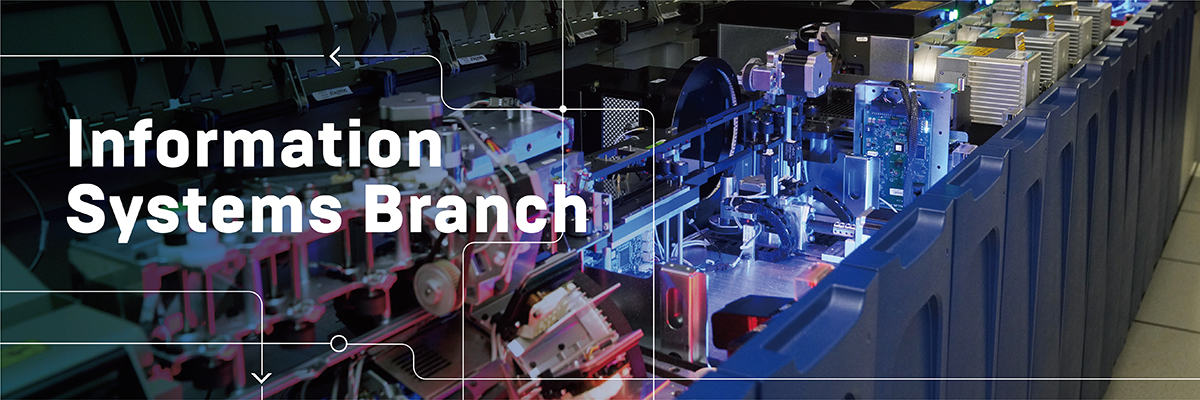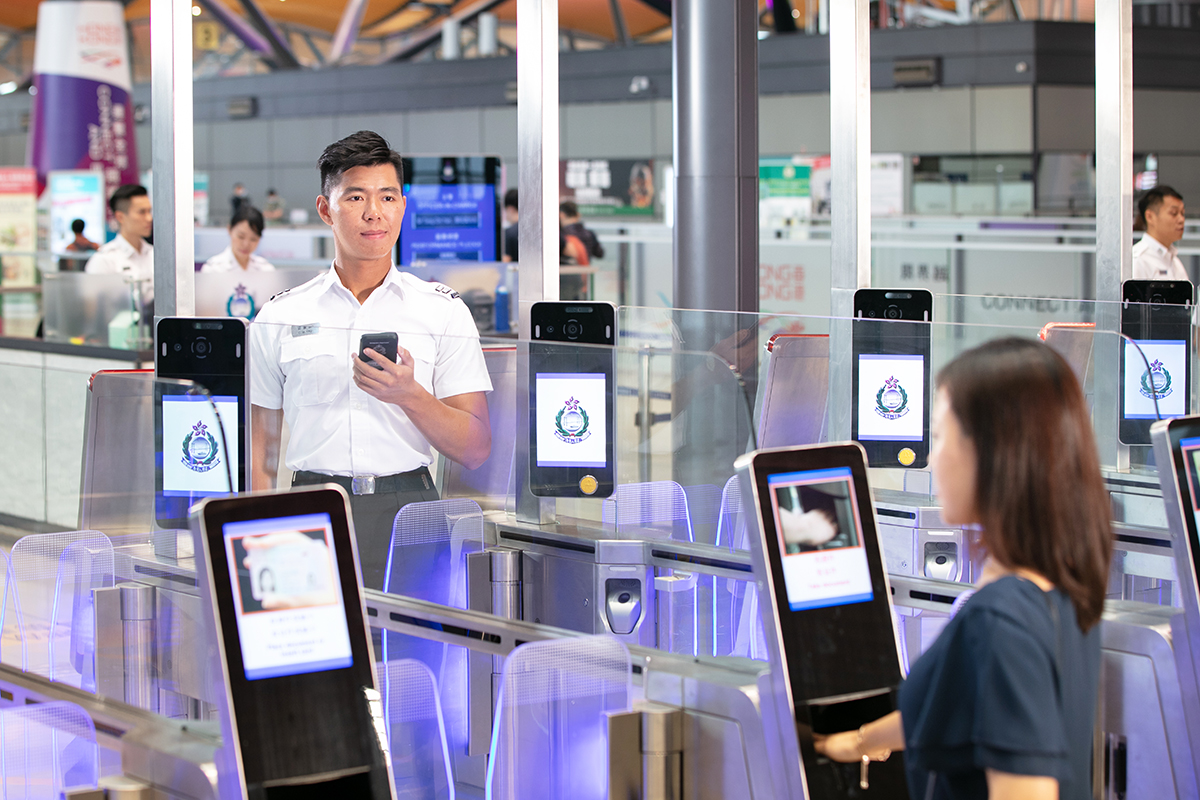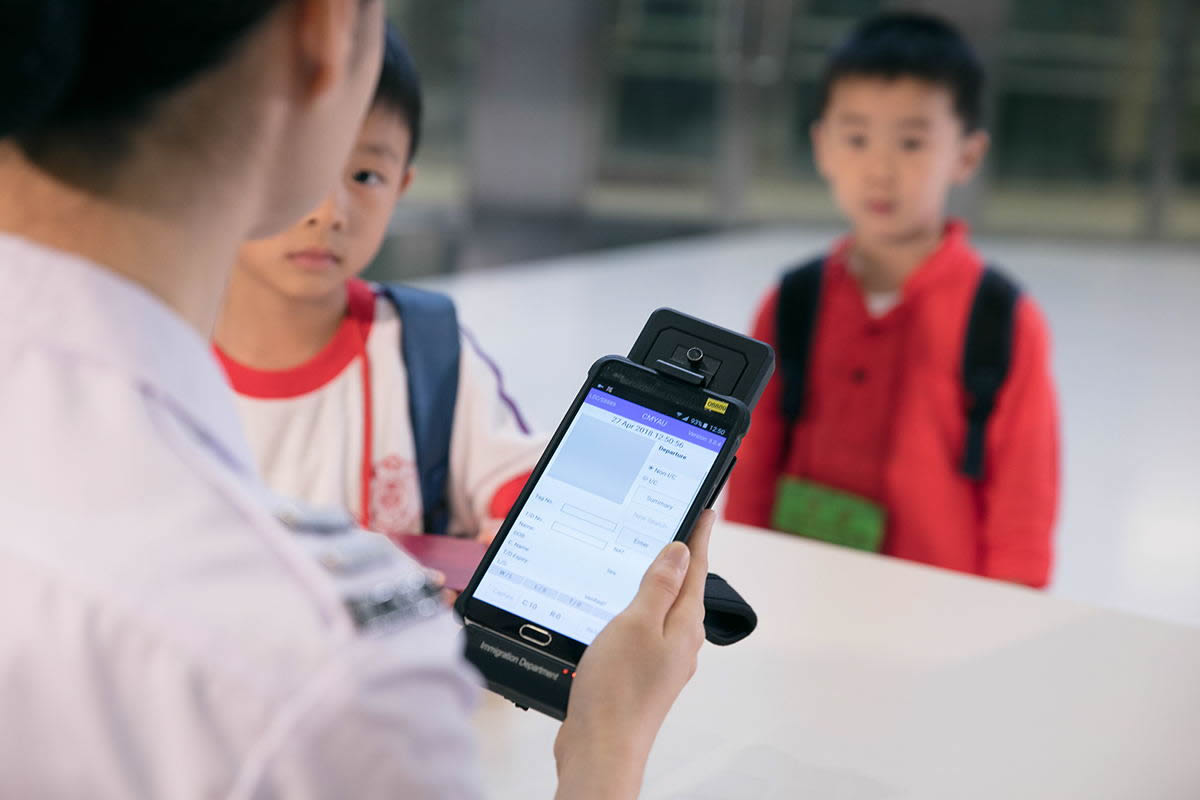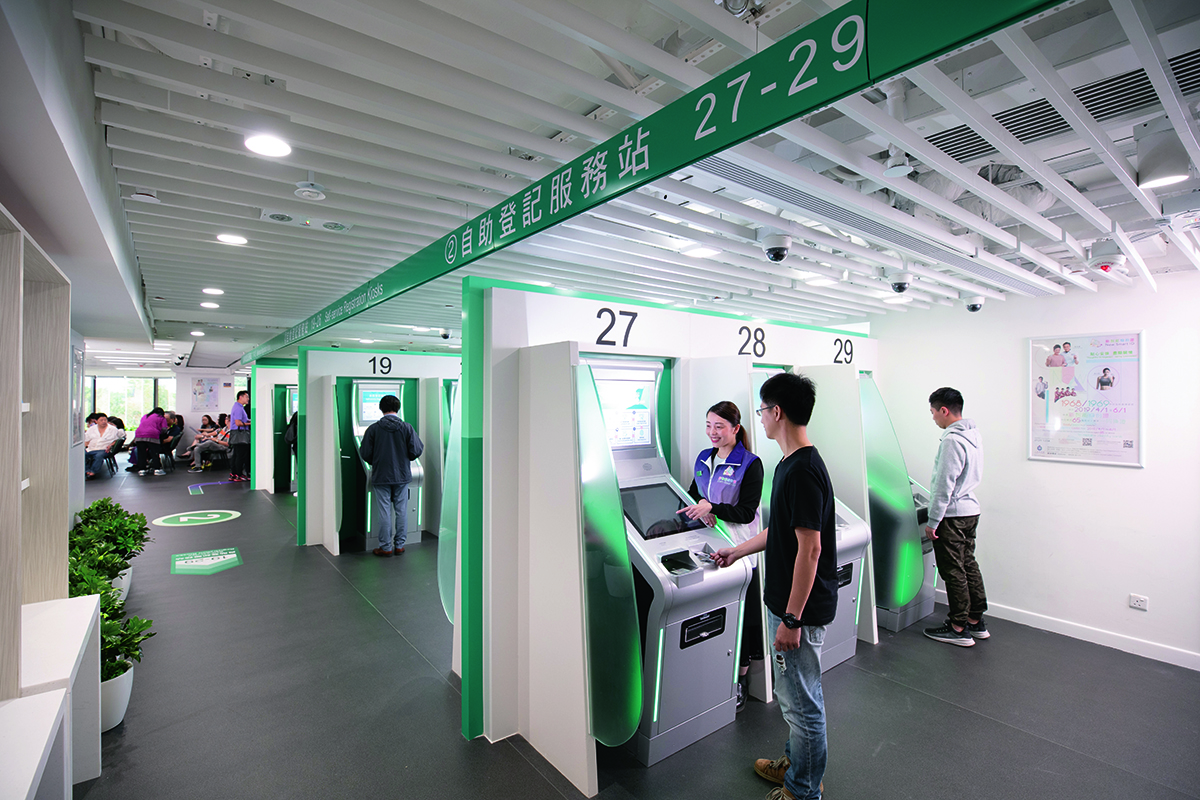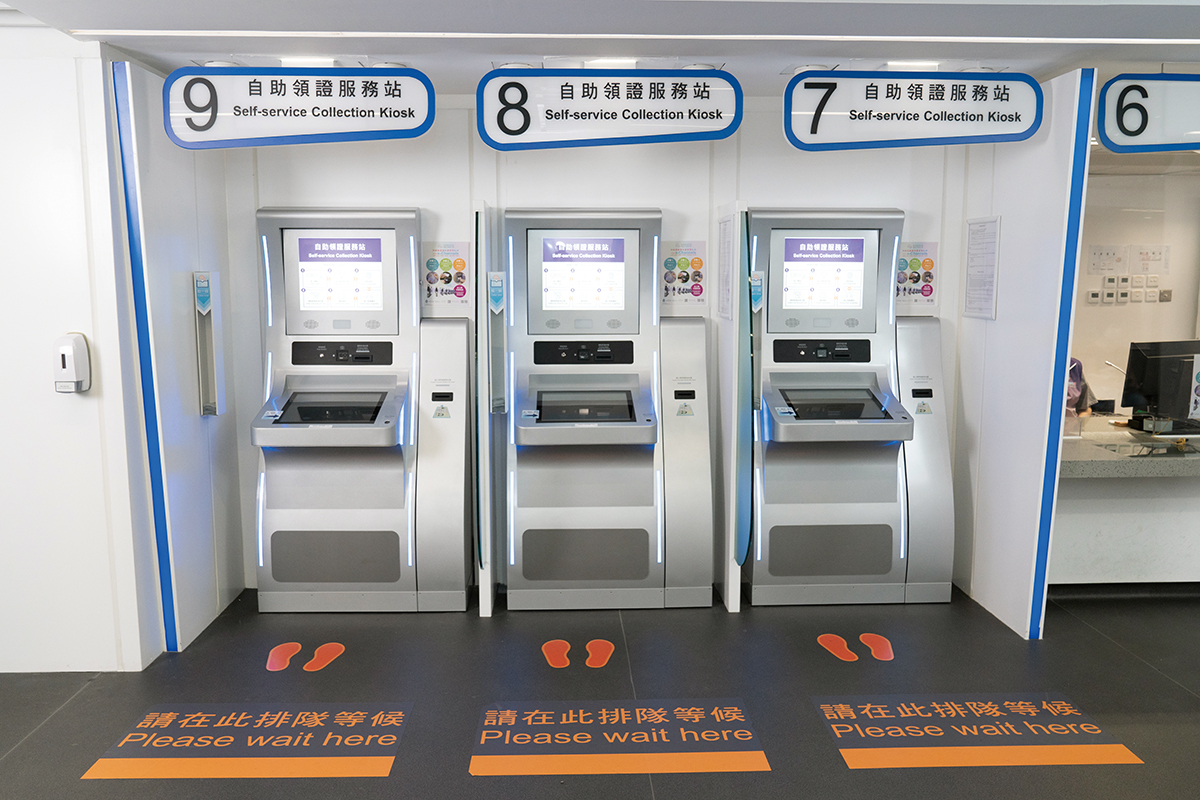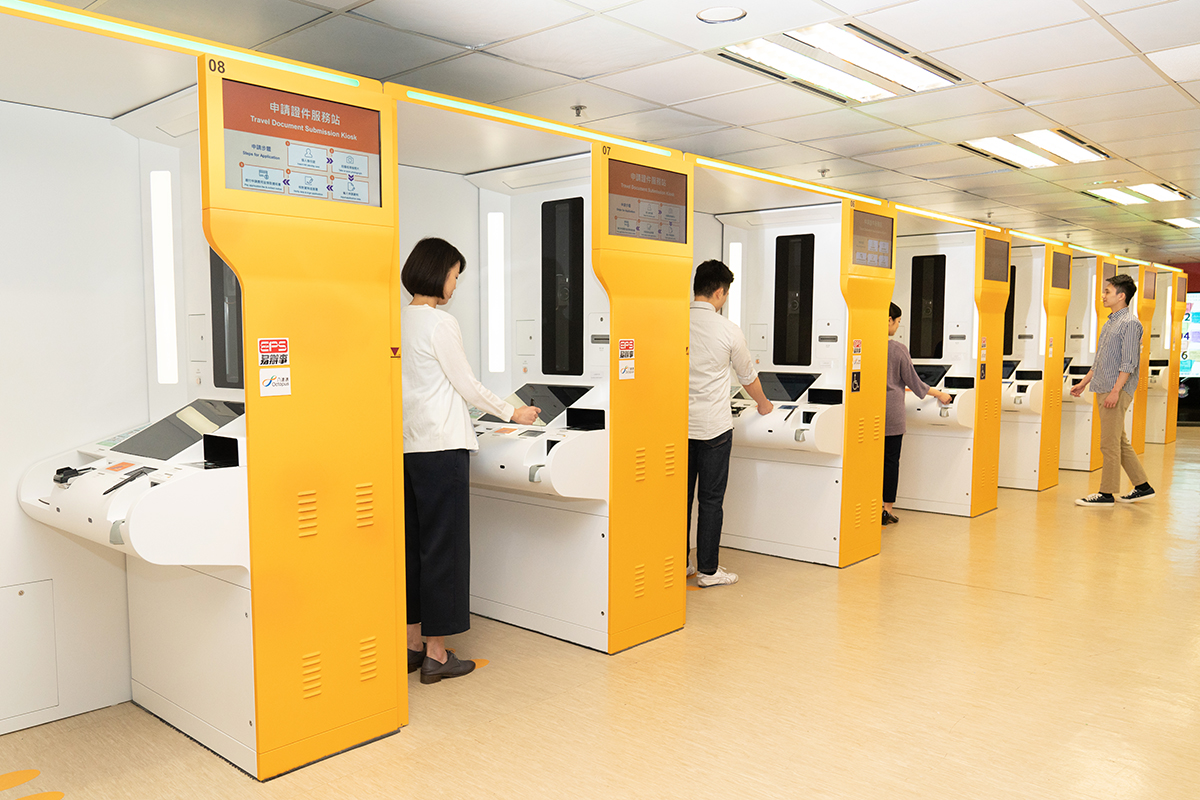The Information Systems Branch is headed by an Assistant Director. It handles all matters concerning development and operation of information systems, records management and personal data privacy of the department.
To cope with the ever-changing social and economic environment, the department has been proactively formulating its information systems strategy to keep pace with the digital era of the 21st century and has been exploring various advanced technologies for delivering efficient and quality services to the public, whilst ensuring the business processes and practices are compliant with the provisions of the Personal Data (Privacy) Ordinance.
The Information Systems Branch comprises four divisions and is tasked to take charge of the information systems and related matters of the department. The Information Systems (Development) Division is responsible for formulating and implementing the department's information systems strategy and developing new information systems to meet future business needs. The Information Systems (Production) Division is responsible for the management and security of information systems in operation as well as the on-going enhancement of the information systems and related processes. The Records and Data Management Division is responsible for all issues relating to data privacy, access to information and management of departmental records. The Technology Services Division provides technical support for the maintenance and development of information systems in the department. The former three divisions are each headed by a Principal Immigration Officer while the Technology Services Division is under the charge of a Chief Systems Manager.
Systems in Operation
Immigration Control System (ICONS)
The department launched ICONS in phases between 2016 and 2017 to replace and consolidate the four ageing control point systems in order to meet new business needs. In addition, the project also included the upgrade of 437 e-Channels to multi-purpose e-Channels, the installation of 158 new multi-purpose e-Channels, the implementation of 'Smart Departure' service that allows eligible visitors holding electronic passports to perform self-service departure clearance at e-Channels without prior enrolment and the introduction of other new functions to enhance the overall handling capacity of control points.
To further enhance the functions of e-Channels and facilitate their use, the department introduced newly designed e-Channels at new control points commissioned in 2018, including the Express Rail Link West Kowloon and the Hong Kong-Zhuhai-Macao Bridge Control Points. Apart from enhancing the efficiency in management and maintenance, the new e-Channels can also provide a more convenient and comfortable user experience for members of the public.
As at the end of 2019, a total of 729 multi-purpose e-Channels were installed at all control points, which could be flexibly deployed for use by eligible Hong Kong residents or visitors.
In December 2007, the e-Channel service at the Lo Wu Control Point was extended to cross-boundary primary school students under the age of 11. The cross-boundary student e-Channel service was further extended to the Lok Ma Chau Spur Line Control Point in May 2015. At present, there are six designated e-Channels for cross-boundary students at the Lo Wu and Lok Ma Chau Spur Line Control Points respectively.
Since late August 2012, simplified clearance procedure for cross-boundary students has been adopted in phases at the Lok Ma Chau Spur Line, Shenzhen Bay, Lok Ma Chau, Sha Tau Kok, Man Kam To and Lo Wu Control Points. With the use of portable clearance devices, more expeditious immigration clearance service has been provided to the enrolled cross-boundary students.
In May 2008, the e-Channel service at the Airport Control Point was extended to frequent visitors aged 18 or above holding a Hong Kong Special Administrative Region (HKSAR) Travel Pass, an Asia-Pacific Economic Co-operation Business Travel Card with the economy code 'HKG' or a Hong Kong International Airport Frequent Visitor Card. The e-Channel service was further extended to eligible members of frequent flyer programmes of various airlines in September 2009. With effect from late April 2012, frequent visitors who hold a valid travel document for which an entry visa/permit for entering Hong Kong is not required, have made visits to Hong Kong by air via Hong Kong International Airport for no less than three times in the past 12 months immediately before enrolment and have no adverse record in Hong Kong may also enrol for e-Channel service.
In order to provide greater travel convenience for both Hong Kong and Macao residents, enrolled Macao permanent residents may use e-Channels for performing immigration clearance at the Macau Ferry Terminal and the China Ferry Terminal from December 2009 onwards. Such an arrangement was extended to the Tuen Mun Ferry Terminal in July 2011 and subsequently to all control points. Reciprocally, eligible Hong Kong residents may use the automated immigration clearance service at control points in Macao. Starting from December 2016, Hong Kong non-permanent residents holding an 'HKSAR Document of Identity for Visa Purposes' and Macao non-permanent residents holding a 'Visit Permit for Residents of Macao to HKSAR' may also enjoy such facilitation.
In March 2009, the Express e-Channel pilot scheme was introduced at the Lo Wu Control Point to provide faster e-Channel service to enrolled Hong Kong residents aged 18 or above who are existing e-Channel users. The service was further extended to the Shenzhen Bay Control Point and the Lok Ma Chau Spur Line Control Point in November 2018.
Since September 2013, the department has launched e-Channels with voice navigation function for the visually impaired persons to perform self-service immigration clearance at the Lok Ma Chau Spur Line Control Point, Macau Ferry Terminal, Shenzhen Bay Control Point and China Ferry Terminal. The service was extended to the Express Rail Link West Kowloon, Hong Kong-Zhuhai-Macao Bridge and Lo Wu Control Points in September, October and December 2018 respectively. To use the service, the persons should first press the activation button at the entrance of the e-Channel to initiate the voice navigation function and voice instructions would be delivered to guide them to complete the clearance process.
Under the arrangement for mutual use of automated immigration clearance services, eligible HKSAR passport holders can enrol for the automated immigration clearance service of the participating countries/territories, whilst eligible passport holders of the participating countries/territories can enrol for the e-Channel service in Hong Kong. Following the arrangements for mutual use of automated immigration clearance services with Korea, Singapore, Germany and Australia, a similar arrangement with Thailand was implemented in September 2018. Moreover, with effect from December 2018, further facilitation for enrolment for automated clearance service has been provided by Hong Kong and Singapore on a mutual basis, so that eligible passport holders of both sides can enjoy greater convenience when they travel between the two places.
The department is actively discussing with other countries/territories on the mutual use of automated immigration clearance services and it is expected that more countries/territories will become our partners.
Starting from September 2015, enrolled Consular Corps Identity Card (CCIC) holders may perform self-service immigration clearance at e-Channels in control points. Moreover, the department introduced in February 2019 a new form of CCIC, which is embedded with a chip module. Enrolled holders can perform immigration clearance at e-Channels with their new CCICs.
Next Generation Smart Identity Card System (SMARTICS-2)
The newly established Self-service Kiosks provide faster and more convenient services for residents.
The SMARTICS-2, an on-line information system that supports the whole process of smart identity card application from appointment booking, registration, production to issuance, is the foundation for the automated immigration clearance service. SMARTICS-2 was launched at the five Registration of Persons Offices in November 2018. In addition, the system functions supporting the territory-wide identity card replacement exercise at the nine Smart Identity Card Replacement Centres came into operation in December 2018. The new smart identity card makes use of the latest polycarbonate materials. On top of the current contact chip interface, the new smart identity card also supports a contactless chip interface, hence reducing wear to the identity card and the chip, making the identity card more durable. A number of new state-of-the-art security features and other sophisticated security designs have been introduced. Coupled with a more complex background with multiple patterns, the new smart identity card has strong protection against photo substitution and counterfeiting. SMARTICS-2 has introduced various new functions and facilities to provide faster and more convenient services for residents, including a mobile application for making appointments for identity card registration or replacement, filling in an electronic form in advance and enquiring about the queuing status. In addition, the newly established Self-service Tag Issuing Kiosks, Self-service Registration Kiosks and Self-service Collection Kiosks provide faster and more convenient services for residents.
To tie in with the introduction of the On-site Identity Card Replacement Service in May 2019, the department developed a new mobile registration system, which has enabled our outreach teams to provide on-site identity card replacement service to residents of residential care homes for elderly persons and persons with disabilities.
Next Generation Electronic Passport (e-Passport-2) System
The e-Passport-2 System supports one-stop-shop travel document application service, including appointment booking, application processing and issuance of travel documents. The e-Passport-2 System was launched on 14 May 2019 to tie in with the issuance of the newly introduced HKSAR Electronic Passport (e-Passport) and Electronic Document of Identity for Visa Purposes (e-Doc/I). In order to effectively enhance the security, reliability and interoperability of the Next Generation e-Passport and e-Doc/I, a number of new state-of-the-art security features, such as tactile relief features, full colour UV printing and a transparent window with the holder's portrait engraved thereon by laser engraving technology, have been introduced. Moreover, to cater for the needs of the visually impaired, the document number and the date of expiry can be printed in braille on the back of the data page of the Next Generation e-Passport and e-Doc/I, thereby faciliating the visually impaired in the identification of their travel documents. The e-Passport-2 System has also introduced various new measures to optimise the passport application process, including support of online submission of passport applications by eligible applicants aged below 11 years old, submission of passport applications via a mobile application and completion of an electronic form in advance upon appointment booking. In addition, applicants may choose to use the self-service photo-taking function at Travel Document Submission Kiosks free of charge, which makes the process faster and more convenient. The kiosks also support Octopus payment function, providing an alternative payment option for the public.
Application and Investigation Easy System (APPLIES) and Electronic Records Programme (ERP)
APPLIES is an on-line information system for processing applications for visas, permits, travel passes, registration matters relating to births, deaths, marriage and investigation cases. Following the full implementation of APPLIES in December 2008, electronic records can be stored and retrieved via computer workstations. With the use of the electronic records and document management systems, there has been service improvement in processing applications and registration matters mentioned above. By adopting advanced technologies and designs, the system is able to handle and maintain operational and administrative records in an efficient and paperless manner. Moreover, with the interface with the Electronic Services System, the public can enjoy e-Services, including booking of appointments and submission of applications through the Internet.
Pre-arrival Registration for Taiwan Residents and Indian Nationals
Pre-arrival Registration for Taiwan Residents was implemented on 1 September 2012 to facilitate eligible Taiwan residents to submit pre-arrival registration electronically through the Internet free of charge and directly without going through airlines in Taiwan. The application result will also be displayed instantly. It provides extra travel convenience for Taiwan residents visiting Hong Kong.
Pre-arrival Registration for Indian Nationals was implemented on 19 December 2016. Indian nationals may apply for pre-arrival registration electronically to visit or transit Hong Kong through the Internet free of charge.
Travel Pass Issuing System
The Travel Pass Issuing System supports the issue of Travel Passes to frequent visitors to Hong Kong. The information on the machine-readable Travel Pass is captured through optical character recognition readers and holders can enjoy speedy immigration clearance at the 'Hong Kong Residents' counters at control points.
Asia-Pacific Economic Co-operation (APEC) Business Travel Card Issuing System
Hong Kong has participated in the APEC Business Travel Card Scheme since 29 May 1998. By making use of the Electronic Data Interchange System, the Scheme facilitates pre-cleared entry of accredited business people to the participating economies of the Asia-Pacific region. Business travel card holders coming to Hong Kong can use the 'Hong Kong Resident' counters at control points for immigration clearance.
Government Office Automation (GOA) System
The GOA System enables speedy communication and dissemination of information through electronic means within the department and among bureaux and departments of the HKSAR Government.
Government-to-Employee (G2E) Applications
The e-Leave System is the first government-to-employee project. All staff members of the department can access the web-based system to process their leave applications and calculate and keep track of leave records through any networked computer workstation in the department.
Operations and Administration Support Information System (OASIS)
OASIS is an online information system which aims at enhancing productivity in operational and administrative areas. It facilitates management of information relating to personnel, stores and inventory.
Electronic Records (Administrative) System (e-Records(Adm))
The e-Records (Adm) System is an electronic records and document management system developed under the Electronic Records Programme. Leveraging advanced information technology and making use of GOA workstations and scanners, the system aims to improve efficiency in handling administrative records in the department. Since April 2008, all staff of the department can use the system to handle administrative records.
Intranet
The Intranet provides an electronic channel for fast dissemination of multi-media information, enhances staff communication and acts as an online self-learning platform within the department.
Immigration Department's Homepage
To better serve the public, the department set up its own homepage on 31 May 1996. Internet users not only can browse the latest information of the department on the homepage, but also can access websites of related government departments/organisations via the hyperlinks provided.
Data Warehousing Information System (DWIS)
The DWIS improves the provision of various statistical analyses that facilitate the management in decision making and resources planning.
Mobile Application
On 5 December 2013, the department launched the Hong Kong Immigration Mobile Application to facilitate Hong Kong residents and visitors in obtaining information on the estimated passenger waiting time at all land boundary control points and other immigration service information such as office hours of all immigration offices anytime, anywhere through their mobile phones or devices. The information on the estimated passenger waiting time is updated about every 15 minutes. It aims to serve as a reference for Hong Kong residents and visitors to choose the land boundary control point and the time to travel at their convenience. The department has continued to enhance the mobile application and enrich its contents, such as the inclusion of Outbound Travel Tips to provide Hong Kong residents with tips when travelling abroad and the link to the department's official YouTube Channel.
Furthermore, to tie in with the introduction of the new smart identity card and the implementation of the Territory-wide Identity Card Replacement Exercise, the mobile application was updated on 26 November 2018 to include new electronic services, namely 'Booking for General HKID Application' and 'Information and Booking for HKID Replacement Exercise'. Following the introduction of the Next Generation e-Passport and e-Doc/I, new functions, namely 'Application for HKSAR Travel Documents', Appointment Booking for 'HKSAR Travel Documents Application' and 'HKSAR Travel Documents Collection' were added to the mobile application on 14 May 2019, providing greater convenience for Hong Kong residents in the application for HKSAR travel documents.
Records and Data Management
The department attaches great importance to personal data privacy and records management and is committed to ensuring that business processes and practices and the handling of all personal data and records are in accordance with the provisions of the Personal Data (Privacy) Ordinance, relevant laws, regulations and guidelines. Departmental policies, guidelines and procedures on personal data protection and records management are set out, regularly reviewed and updated to ensure staff compliance in proper handling of personal data and management of records. To further enhance the protection of personal data privacy and records management, the department has implemented the Privacy Management Programme. The Privacy Compliance Group has also been formed to monitor the department's overall privacy compliance situation and review the related programme controls. Moreover, training sessions, seminars and workshops are conducted to cultivate a culture of respect for privacy by increasing staff's awareness of personal data privacy protection and good records management as well as staff's competence in handling data access requests and access to information applications.
Electronic Services
Electronic services have been launched in phases at the GovHK website since 30 October 2007. As at 31 December 2019, members of the public and other users could access the following electronic services via the GovHK website:
- apply for search of birth/death/marriage records and certified copies of such records;
- apply for an HKSAR Passport;
- apply for verification of eligibility for permanent identity card and submit supplementary documents;
- apply for extension of stay and submit supplementary documents (except visitors and certain application types);
- apply for an entry visa under the Admission Scheme for the Second Generation of Chinese Hong Kong Permanent Residents;
- make an appointment for giving notice of intended marriage and submit information required for registration of marriage;
- make an appointment for birth registration and submit information required for registration of birth;
- make an appointment for identity card application (Registration of Persons Offices) and fill in a form in advance;
- make an appointment for replacement of identity card (Territory-wide Identity Card Replacement Exercise) and fill in a form in advance;
- make an appointment for applying for HKSAR travel documents and fill in a form in advance;
- make an appointment for collection of an HKSAR Passport or a Document of Identity for Visa Purposes;
- make an appointment for applying for extension of stay (except visitors and certain application types);
- change or enquire about an appointment for document verification relating to verification of eligibility for permanent identity card;
- enquire about the status of application for verification of eligibility for permanent identity card;
- enquire about the status of application for a Hong Kong visa;
- file notification of pre-mature termination of an employment contract with a foreign domestic helper;
- report immigration offences;
- apply for access to information of the Immigration Department;
- apply for a Certificate of Absence of Marriage Record;
- apply for pre-arrival registration for Taiwan residents; and
- apply for pre-arrival registration for Indian nationals.
Electronic Submission
Since 2000, the department has been accepting electronic information sent by members of the public in specified format, manner and procedures requesting immigration services in accordance with the provisions of the Electronic Transactions Ordinance. Examples are provision of prescribed particulars of crew and passengers by an aircraft captain under the Immigration Ordinance and making requests for a Certificate of Registrar of Marriages for marriage to be solemnised in church under the Marriage Ordinance. Details can be found at the department's homepage: www.immd.gov.hk.
Electronic Forms
Apart from accepting applications submitted by applicants in person or by post, the department has devised electronic forms for the public to fill in and submit through the Internet for the following purposes:
- notification of change of particulars previously registered;
- notification of change of address;
- application for amendment of registered particulars of a Hong Kong identity card; and
- application for access to information.
These electronic forms can be downloaded from the department's homepage.
Implementation of the Third Information Systems Strategy (ISS-3)
To improve its service quality, the department commissioned a consultant to conduct the ISS-3 Review in March 2010 with a view to formulating a long-term information systems strategy. The Review recommended the department to implement the following separate but inter-related systems to enhance its service quality and capacity to meet the challenging business requirements in the coming years.
- New IT Infrastructure (ITI);
- Immigration Control System (ICONS);
- Next Generation Smart Identity Card System (SMARTICS-2);
- Next Generation Electronic Passport System (e-Passport-2);
- Next Generation Application and Investigation Easy Systems (APPLIES-2), including:
- Visa Automation System;
- Assistance to Hong Kong Residents, Births, Deaths & Marriage, Right of Abode Decision Support System;
- Enforcement Case Processing System; and
- Human Resources Management System (HRMS).
Two data centres and a new IT infrastructure under the New IT Infrastructure project have commenced operation since 2014 and 2015 respectively and ICONS was fully implemented in 2017. Moreover, SMARTICS-2 was launched in 2018 to tie in with the implementation of the Territory-wide Identity Card Replacement Exercise.
For the APPLIES-2 project, the tender exercise has been completed and system development is in progress. APPLIES-2 includes Visa Automation System; Assistance to Hong Kong Residents, Births, Deaths & Marriage, Right of Abode Decision Support System; and Enforcement Case Processing System, which is expected to be implemented in phases starting from the second half of 2021. As regards the HRMS, the feasibility study will commence in the first half of 2020.
Achievement
Team Award (Specialised Service) under the Civil Service Outstanding Service Award Scheme 2019
In December 2019, Smart Departure, the department's self-service departure clearance service for visitors, won the Team Award (Specialised Service) - Meritorious Award under the Civil Service Outstanding Service Award Scheme 2019 in recognition of our application of smart technology in delivering quality public service to visitors.


